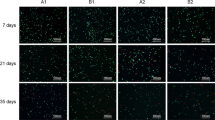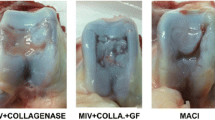Abstract
For the purpose of human meniscal allografting, menisci have been maintained viable in in vitro culture. The influence of long-term tissue culture on the extracellular matrix metabolism of the meniscus has been studied. Fetal calf serum (FCS) was used as a supplement for the growth factors necessary to maintain optimal meniscal cell metabolism. A series of semilunar cartilage samples was cultured under serum-free conditions since foreign proteins could be responsible for immunological problems after eventual allografting. The proteoglycan metabolism in human menisci cultured in FCS-supplemented and in serum-free culture media was compared. To rule out any influence of topographical variations in glycosaminoglycan (GAG) content on proteoglycan (PG) metabolism, GAG concentrations within the tissue were determined, and sulphate (35S) incorporation was studied in tissue samples with a comparable biochemical composition. Sulphate incorporation was preserved when 20% FCS was added to the nutrient medium. The meniscal tissue fibroblasts continued to produce35S-PG during 4 weeks of culture. The PG molecules were shown to consist of PG-aggregates, monomers and a low molecular-weight PG population. Newly synthesized GAG consisted of approximately 55% chondroitin 4- and 6-sulphate and 33% dermatan sulphate. In the presence of serum.35S incorporation in PG and in the PG-aggregate fraction significantly increased during the first 2 weeks and then decreased during the following 2 weeks of in vitro culture. Newly synthesized PG-aggregates were almost entirely accumulated in the tissue during these weeks. In the 3rd week the values for this parameter decreased slightly.35S-PG synthesis dramatically declined after 4 weeks of in vitro culture. Catabolism probably resulted in increased proportions of35S-PG in the incubation media. In the absence of serum,35S-PG production also increased in the 2nd week of culture. However,35S activity was almost exclusively found in small PG, and this material apparently diffused to the incubation media. Consequently, catabolism is higher, and the immobilization of35S-PG is poor when FCS is not added to the culture media. Our findings suggest that menisci are maintained in viable condition and may serve for allografting at least during 2 weeks of tissue culture.
Similar content being viewed by others
References
Adams ME, Ho YA (1987) Localization of glycosaminoglycans in human and canine menisci and their attachments. Connect Tissue Res 16: 269–279
Adams ME, Muir H (1981) The glycosaminoglycans of canine menisci. Biochem J 197: 289–385
Arnoczky SP, McDevitt CA, Schmidt MB, Mow VC, Warren RF (1988) The effect of cryopreservation of canine menisci. A biochemical morphological and biomechanical evaluation. J Orthop Res 6: 1–12
Bayliss MT, Ali SY (1981) Age-related changes in human articular proteoglycans. Semin Arthritis Rheum 11 [Suppl 1]: 20–21
Canham W, Stanish W (1986) A study of the biological behavior of the meniscus as a transplant in the medial compartment of dog's knee. Am Orthop Soc Sports Med 14: 376–379
Cheung HS (1987 Distribution of type I, II, III and V in the pepsin solubilized collagens in bovine menisci. Connect Tissue Res 16: 343–350
Farndale RW, Sayers CA, Barrett AJ (1982) A direct spectrophotometric microassay for sulphated glycosaminoglycans in cartilage cultures. Connect Tissue Res 9: 247–248
Fithian DC, Kelly MA, Mow VC (1990) Material properties and structure-function relationships in the menisci. Clin Orthop 252: 19–31
Ghosh P, Ingman AM, Taylor KFT (1975) Variations in collagen, non-collagenous proteins, and hexosamine in menisci derived from osteoarhritic and rheumatoid arthritic knee joints. J Rheumatol 2: 100–107
Herwig J, Egner E, Buddecke E (1984) Chemical changes of human knee joint menisci in various stages of degeneration. Ann Rheum Dis 43: 635–640
Luyten FP, Verbruggen G, Veys EM (1987) Reparative response of human articular cartilage in tissue culture. Comparison between a normal and an osteoarthritic knee of the same donor. Clin Exp Rheumatol 5: 103–110
Pearson JP, Mason RM (1977) The stability of bovine nasal cartilage proteoglycans during isolation and storage. Biochim Biophys Acta 498: 176–188
Schmid A, Schmid F, Tiling F (1988) Electron microscopic studies on human meniscal tissue preserved for transplantation. In: Müller W, Hackenbruch W (eds) Surgery and arthroscopy of the knee. Proceedings of the second ESKA Congress. Springer, Berlin Heidelberg New York, pp 703–707
Simon WH, Wohl DL (1982) Water content of equine articular cartilage: effects of enzymatical degradation on artificial fibrillation. Connect Tissue Res 9: 227–232
Teshima R, Treadwell BJ, Trahan CA, Mankin JH (1983) Comparative rates of proteoglycan synthesis and size of protcoglycans in normal and osteoarthritic chondrocytes. Arthritis Rheum 26: 1225–1230
Verbruggen G, Luyten FP, Veys EM (1985) Repair function in organ cultured human articular cartilage. Replacement of enzymatically removed proteoglycan during long-term organ culture. J Rheumatol 12: 665–674
Verdonk R, Van Dacle P, Claus B, Vandenabeele K, Desmet P, Verbruggen G, Veys EM, Claessens H (1994) Das vitale Meniskustransplantat. Orthopäde 23: 153–159
Webber RJ, Hough AJ Jr (1988) Cell culture of rabbit meniscal fibrochondrocytes II. Sulphated proteoglycan synthesis. Chemie 70: 193–204
Webber RJ, Norby DP, Malemud CJ, Goldberg VM, Moscowitz RW (1984) Characterization of newly synthesized proteoglycans from rabbit menisci in organ culture. Biochem J 221: 875–884
Yamagata T, Saito H, Habuchi O, Suzuki S (1968) Purification and properties of bacterial chondroitinase and chondrosulfatases. J Biol Chem 243: 1523–1535
Zukor DJ, cameron JC, Brooks PJ, Oakeshott RD, Gross AE (1988) The fate of human meniscal allografts. Orthop Trans 12: 658
Author information
Authors and Affiliations
Rights and permissions
About this article
Cite this article
Verbruggen, G., Verdonk, R., Veys, E.M. et al. Human meniscal proteoglycan metabolism in long-term tissue culture. Knee Surg, Sports traumatol, Arthroscopy 4, 57–63 (1996). https://doi.org/10.1007/BF01566000
Received:
Accepted:
Issue Date:
DOI: https://doi.org/10.1007/BF01566000




